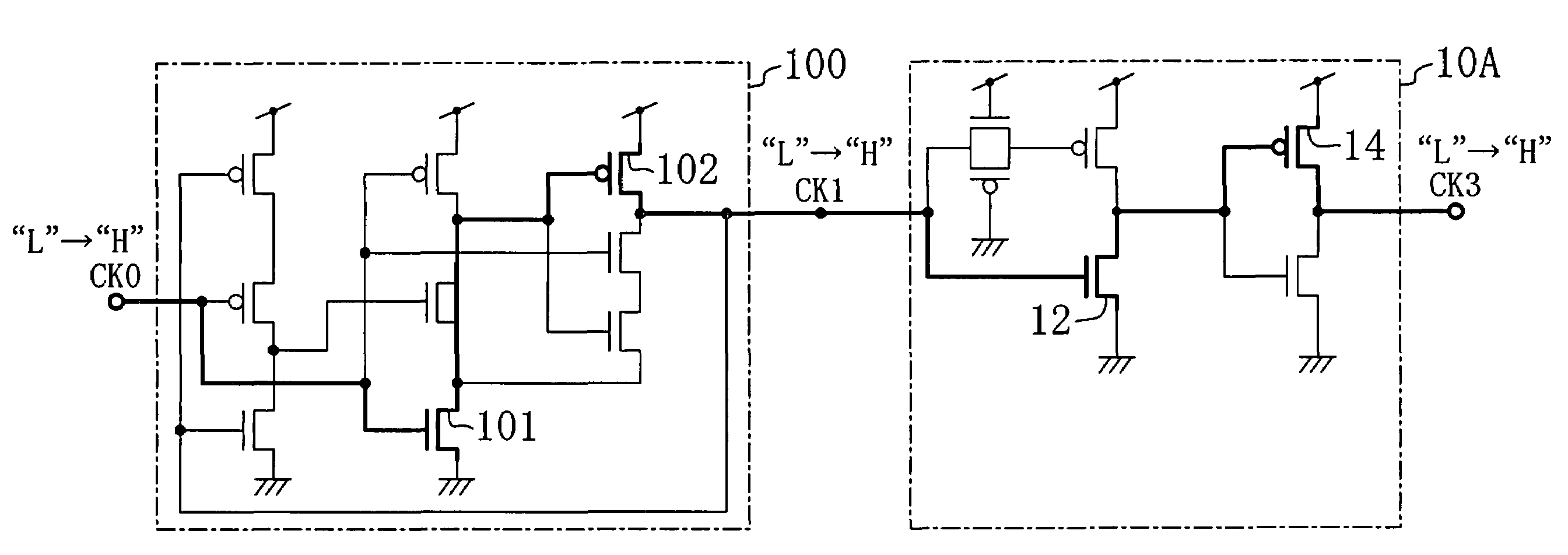Duty cycle correction circuit
a duty cycle and circuit technology, applied in the direction of generating/distributing signals, pulse manipulation, pulse techniques, etc., can solve the problems of error db>3/b> cannot be neglected, and become difficult to provide a clock signal with a 50% duty cycl
- Summary
- Abstract
- Description
- Claims
- Application Information
AI Technical Summary
Benefits of technology
Problems solved by technology
Method used
Image
Examples
first embodiment
(First Embodiment)
[0031]FIG. 1 shows a circuit configuration of a duty cycle correction circuit according to a first embodiment of the present invention. A duty cycle correction circuit 10A of this embodiment includes a delay unit 11A, an n-channel transistor 12, a p-channel transistor 13, and an inverter circuit 16. The delay unit 11A delays a clock signal CK1 (corresponding to a first clock signal) which is given to the duty cycle correction circuit 10A to output a clock signal CK2 corresponding to a second clock signal. The n-channel transistor 12 has a source supplied with a ground voltage and a gate supplied with the clock signal CK1. The p-channel transistor 13 has a source supplied with a source voltage and a gate supplied with the clock signal CK2. The inverter circuit 16 is composed of transistors 14 and 15 and inverses a signal CK3′ output by a common drain of the transistors 12 and 13 to output a clock signal CK3 corresponding to a third clock signal. In addition, the tra...
second embodiment
(Second Embodiment)
[0047]FIG. 4 shows a circuit configuration of a duty cycle correction circuit according to a second embodiment of the present invention. A duty cycle correction circuit 10B of this embodiment is configured by replacing the delay unit 11A of the duty cycle correction circuit 10A according to the first embodiment with a delay unit 11B having a different circuit configuration from the delay unit 11A. The duty cycle correction circuit 10B also includes a clock-signal output unit 18 with the same circuit configuration as the duty cycle correction circuit 10A but the absence of the inverter circuit 16. The clock-signal output unit 18 outputs the signal CK3′ shown in FIG. 1 as the clock CK3. The description of the components shown in FIG. 4 that are the same as those shown in FIG. 1 will be omitted by retaining the same reference numerals. Hereinafter, only the delay unit 11B will be described.
[0048]The delay unit 11B has a transfer gate 113 composed of an n-channel tran...
third embodiment
(Third Embodiment)
[0052]FIG. 5 shows a circuit configuration of a duty cycle correction circuit according to a third embodiment of the present invention. A duty cycle correction circuit 10C of this embodiment is configured by replacing the delay unit 11B of the duty cycle correction circuit 10B according to the second embodiment with a delay unit 11C having a different circuit configuration from the delay unit 11B. The description of the components shown in FIG. 5 that are the same as those shown in FIG. 4 will be omitted by retaining the same reference numerals. Hereinafter, only the delay unit 11C will be described.
[0053]The delay unit 11C has a p-channel transistor 112. A gate of the transistor 112 is supplied with a gate threshold voltage Vth of the transistor 112. Since the transistor 112 is of p-channel type, the voltage supplied thereto is lower than the ground voltage. Thus, by supplying the gate of the transistor 112 with the gate threshold voltage Vth, the switching operat...
PUM
 Login to View More
Login to View More Abstract
Description
Claims
Application Information
 Login to View More
Login to View More - R&D
- Intellectual Property
- Life Sciences
- Materials
- Tech Scout
- Unparalleled Data Quality
- Higher Quality Content
- 60% Fewer Hallucinations
Browse by: Latest US Patents, China's latest patents, Technical Efficacy Thesaurus, Application Domain, Technology Topic, Popular Technical Reports.
© 2025 PatSnap. All rights reserved.Legal|Privacy policy|Modern Slavery Act Transparency Statement|Sitemap|About US| Contact US: help@patsnap.com



